As soon as we crossed into Austria yesterday the roads improved fantastically and we were able to drive at a reasonable speed without fear of a cracked axle. Vienna is only about 40 kilometres into Austria and being Sunday the streets of Vienna were not too crowded so we crossed the city and found the campsite with little difficulty.
The hot weather continues and is becoming a real issue. It is too hot to move and the last place we ought to be is in a huge city of more than 1,500,000 inhabitants. Twenty per cent of the population of Austria live in Vienna. It is an enormous city for the size of the country, which is one of the smallest in Europe.
We are sorry to sound such moaning wimps but heat really is a problem in an open field in a tiny vehicle which has to be left closed while we are out seeking shade during the day. So when we return it takes most of the night for it to cool down enough to sleep. This morning we were up by 6.30am and already it was too hot. By 7.30am we were ready to catch the bus and U-bahn into the centre of the city.
There is no doubt Vienna is a magnificent place with huge palaces, countless statues and monuments, beautiful, rose-filled gardens and vast open spaces for the sun to beat relentlessly down between the main buildings constructed with the wealth of the Habsburgs. Many of these buildings today house the city's art treasures and the many museums. The collections are of world renown but today being Monday all these treasures were closed to us. Not that it mattered as there was far too much to see outside anyway but it would have offered some respite from the weather. However, the magnificent early mediaeval gothic cathedral did this to perfection. Huge and cool inside with soaring sandstone columns, gothic tracery and fan vaulting ascending to the high arched roof, it was a total contrast to the smaller, later, more decorated baroque churches we saw in Hungary. Here the Cathedral relied on the lines of its architecture for sheer beauty with stunning carving for decoration.
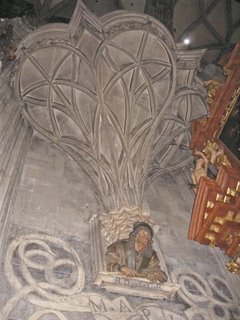 Cathedral of St. Stephen, Vienna
Cathedral of St. Stephen, Vienna Cathedral of St. Stephen with glazed tiled roof, Vienna
Cathedral of St. Stephen with glazed tiled roof, Vienna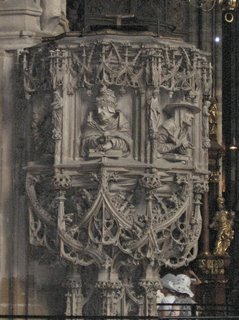 Pulpit by Anton Pilgram, 1511, Cathedral, Vienna
Pulpit by Anton Pilgram, 1511, Cathedral, Vienna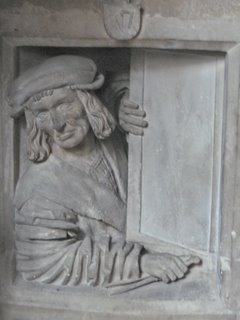 Carving of the architect on the pulpit, c1500, Cathedral, Vienna
Carving of the architect on the pulpit, c1500, Cathedral, ViennaWe also discovered the beautiful church of St. Michael where we rested, tingling as the cool air condensed on our hot bodies, listening to a magnificent organ recital of early 17th century music which reverberated around the church filling every niche and alcove with sound. It is the largest organ in Vienna and admirably illustrated the benefits of churches being so large and lofty.
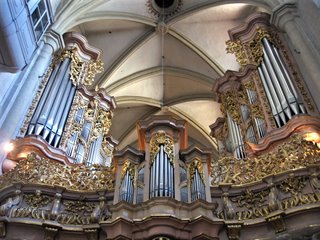 Organ in the church of St. Michael, Vienna
Organ in the church of St. Michael, Vienna Altar in the church of St. Michael, Vienna
Altar in the church of St. Michael, Vienna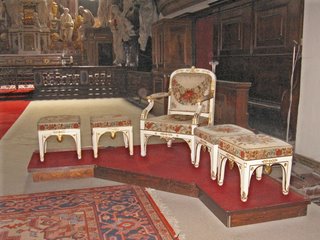 Very Austrian! Beside the altar, St. Michael, Vienna
Very Austrian! Beside the altar, St. Michael, ViennaWe paused for a coffee during the morning - after all our day had started early and we were feeling very weary. The price for a couple of coffees in Austria was well in excess of the prices we had been paying for some three course meals in Hungary! So, our diet started today with us skipping lunch – no hardship in this heat. We did get hungry halfway through the afternoon and shared a salad roll in one of the parks but our time there was spoilt by a beggar lady and her husband who should be nominated for an Oscar for their outstanding performance of pathetic misery as they tried to part us from our euros. It is always so hard to deal with as we have no understanding of the background that leads them to be in such straitened circumstances in such an affluent city on a hot afternoon. After seeing how convincing the acting was in Venice when we saw the "destitute beggar girls" clocking off and going off for a cheerful drink together with their "earnings" we've not trusted anyone. Today too we were approached by a well dressed young man saying he needed money urgently to help his poor mother who was desperately ill. We have already come across that one before so he got short shrift from us, but there is always the nasty thought that, just supposing they are genuine and we have refused to help.
Unable to bear the heat any longer we plunged into an internet café which was blissfully air conditioned and spent well over an hour there sheltering from the very worst heat of the day around 2pm.
Walking through the Stadtpark we discovered a golden statue of Johann Strauss the younger. As Ian went to take a photo a dozen Japanese tourists arrived and crowded in front taking photos of each other. We waited patiently as we have become accustomed to doing with the Japanese in European cities while eleven of them photographed the one posed with Strauss. Then they swapped, one by one, each having their photo taken! We gradually started to feel irritated rather than amused. Eventually Jill decided she might as well be in the picture too and strode up to pose beside them. They were totally disconcerted and probably thought us very rude. Twelve very cross Japanese tourists gesticulated and the young lady being photographed moved away from Strauss. So did Jill as this was our intention but she immediately moved back. So did Jill. They were quite unable to realise anyone might want to take a quick picture of the actual statue! Giving up, we went for a beer and returned later when they had finished. As we returned a young man asked us if we would photograph him and his girlfriend in front of the statue! We finally got our own picture just as we saw another group of oriental tourists approaching! Almost the most boring thing in the world must be an evening in Tokyo looking at each other's holiday pictures of them standing in front of Europe. (Marginally worse may be wading through countless editions of the Maxted Travels blog).
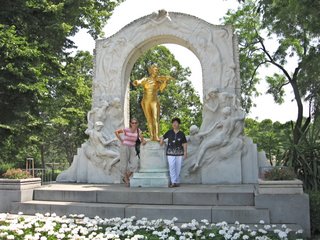 Johann Strauss, Jill and a cross Japanese lady, Vienna
Johann Strauss, Jill and a cross Japanese lady, Vienna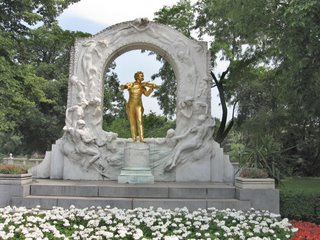 Johann Strauss alone at last, Vienna
Johann Strauss alone at last, ViennaVienna is a city of music with countless concerts taking place at stunning venues ranging from the gardens of Schönbrunn to the Kursalon in the Stadtpark. Young people dressed like Mozart were around the streets publicising the events and answering questions. We discovered the house where Mozart lived but did not visit. Ian spent the entrance money nearby on a collection of CDs of the composer's early music instead.
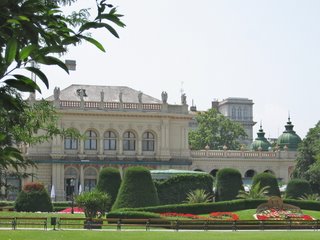 Kursalon from the Stadtpark, Vienna
Kursalon from the Stadtpark, Vienna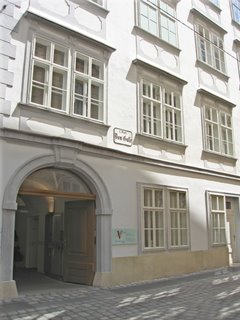 Mozart's house, Vienna
Mozart's house, ViennaIt is not going to be possible to do any sort of justice to the city of Vienna. There is just so much to see, all of it superlatively large and magnificent but when you are so hot, sticky and thirsty and it takes real effort to place one foot in front of the other you don't really appreciate what you are seeing. We did take a few pictures though they do the city no justice either. But let each of them be worth a thousand words so we can spend the evening sitting outside Modestine in relative comfort listening to Ian's cut-price CDs rather than blogging.
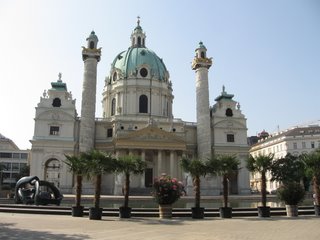 Karlskirche, Vienna
Karlskirche, Vienna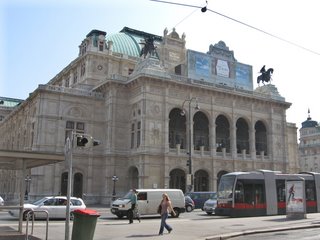 Staatsoper, Vienna
Staatsoper, Vienna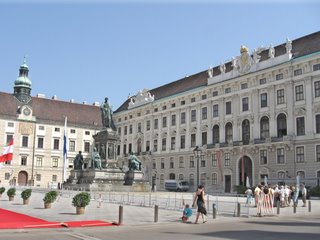 Burgplatz, Vienna
Burgplatz, Vienna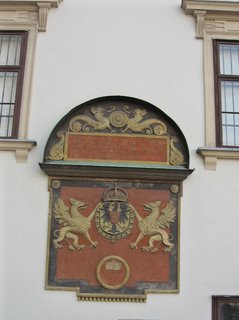 Renaissance coat of arms in the Alte Hofburg, Vienna
Renaissance coat of arms in the Alte Hofburg, Vienna Michaelertor, Vienna
Michaelertor, Vienna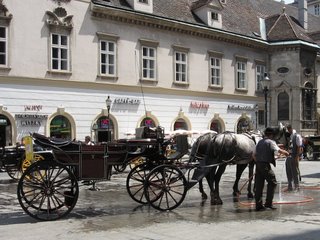 Watering the horses, Vienna
Watering the horses, Vienna Preventing sunburned ears, Vienna
Preventing sunburned ears, Vienna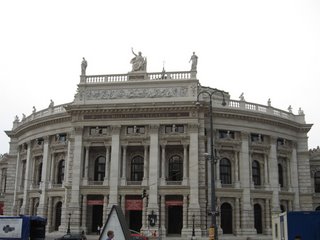 Burgtheater, Vienna
Burgtheater, Vienna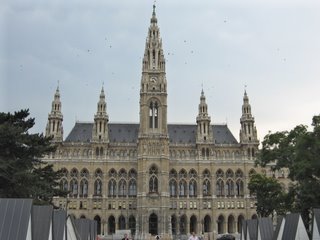 Rathaus, Vienna
Rathaus, Vienna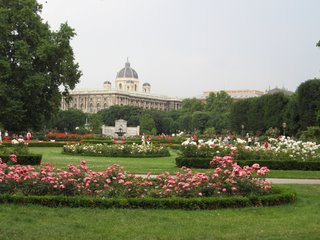 Hofburg from the Volksgarten, Vienna
Hofburg from the Volksgarten, Vienna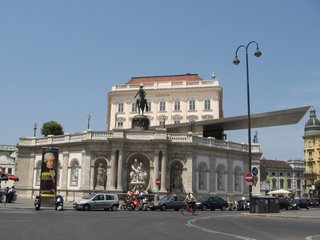 Albertina in the Hofburg complex housing the world's largest print collection, Vienna
Albertina in the Hofburg complex housing the world's largest print collection, Vienna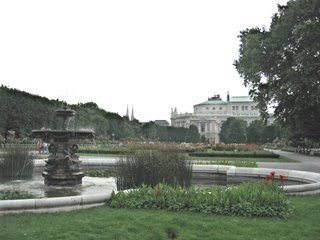 Burgtheater from the Volksgarten, Vienna
Burgtheater from the Volksgarten, Vienna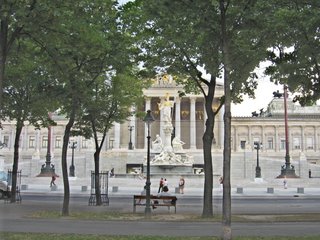 Parliament from the Volksgarten, Vienna
Parliament from the Volksgarten, Vienna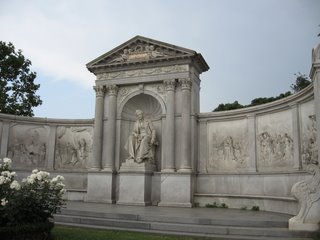 Monument to Grillparzer (the leading 19th century Austrian dramatist), Volksgarten, Vienna
Monument to Grillparzer (the leading 19th century Austrian dramatist), Volksgarten, Vienna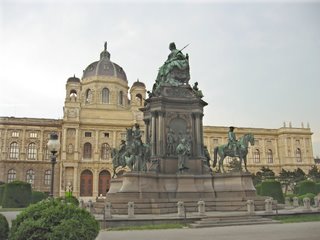 Empress Maria Theresa in front of the Kunsthistorisches Museum, Vienna
Empress Maria Theresa in front of the Kunsthistorisches Museum, ViennaTuesday 27th June 2006 Vienna, Austria
This morning the weather was slightly cooler with a threat of rain. We decided to stay another day and we are really glad we did as we now have a much fuller impression of the city. Although it became very hot, humid and sunny around lunchtime, we were able to explore the town during the morning without needing to follow the shade around three sides of every building. An overcast sky can make life so much more bearable.
We took the tram into the city, impossible with the heat yesterday and still unpleasantly sticky today but it did give us a clearer picture of the city and its layout. Our five euro day card for public transport meant that we could get on and off buses and trams as we pleased - really useful now we had sufficient energy and enthusiasm for sightseeing.
We started the day with the Austrian parliament, a magnificent building with a classic Greek portico and flamboyant statues and fountains on a grand scale in front.
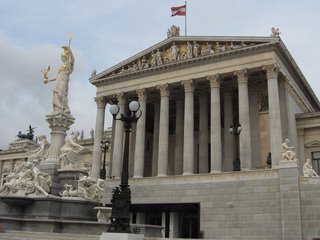 Parliament building, Vienna
Parliament building, Vienna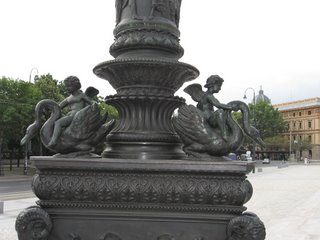 Detail of a lamp post in front of the Parliament building, Vienna
Detail of a lamp post in front of the Parliament building, Vienna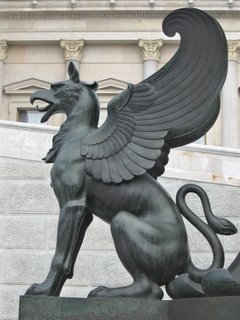 Griffin in front of the Parliament building, Vienna
Griffin in front of the Parliament building, ViennaFurther along the avenue we called in at the University, the forecourt crowded with young students and bicycles. Sigmund Freud used to lecture here. Nearby we discovered a park dedicated to him. However, it was a disappointment to find it was not a "complex" park, just a grassy area, and there were no statues - erotic or neurotic. The only possible Freudian connection we could find was an illustrated sign indicating that only anally retentive dogs were permitted in the park.
Next we caught the tram out to the Prater. This is a large parkland area on the edge of the city. It is a permanent fairground with a couple of huge Ferris wheels and a collection of really scary "thrills and spills" rides that brought delight to hundreds of teenagers who took some kind of masochistic pleasure in being hurled around high above the fairground, held back into their seats by centrifugal force. We felt sick just watching them. Other visitors preferred to spend their day at the beer stands with large tankards and plates of Wurst, mustard and white bread rolls. It was nothing like as animated as the Munich beer festival we visited last year but this fairground is presumably like this throughout the year rather than for a couple of weeks.
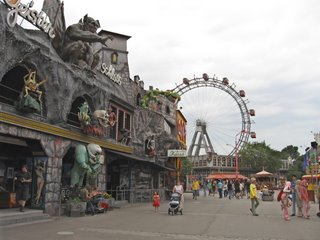 Big wheel – over 100 years old, with more recent fairground rides, Prater, Vienna
Big wheel – over 100 years old, with more recent fairground rides, Prater, ViennaReturning to the city we stopped to visit Hundertwasser Haus. Intended as a new concept in public housing design in the 1980s today it looks rather dated. It is actually a block of council flats where the occupants have to suffer crowds of visitors every day who come to photograph the building. Hundertwasser's intention had been to make living space more interesting so the building was painted in a variety of different colours and decorated with mosaic designs. Nearby was a small shopping precinct, part of the same complex, were we discovered a "toilet of modern art". In the interests of photography Ian spent 60 centimes to see inside the gents' loo.
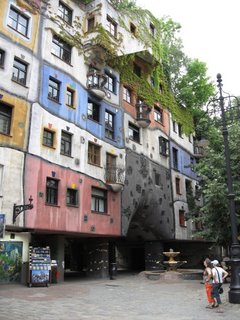 Hundertwasser Haus, Vienna
Hundertwasser Haus, Vienna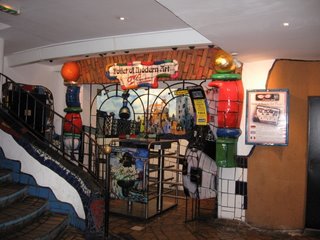 Toilet of Modern Art near the Hundertwasser Haus, Vienna
Toilet of Modern Art near the Hundertwasser Haus, Vienna Interior of the Toilet of Modern Art near the Hundertwasser Haus, Vienna
Interior of the Toilet of Modern Art near the Hundertwasser Haus, ViennaLater, beside the State Opera House we discovered another eccentric toilet. This time Jill took the camera and disappeared through the turnstile into the ladies room where a large photo of Stauss adorned the walls, vases were filled with artificial flowers and piped music played Viennese waltzes. However, it seemed poor value for the price, so while Ian kept a warning lookout from beyond the turnstile, Jill took a few photos in the gents' which was a lot more interesting as can be seen from the urinals shown here. It is not often either, that one comes across a piano in a public toilet.
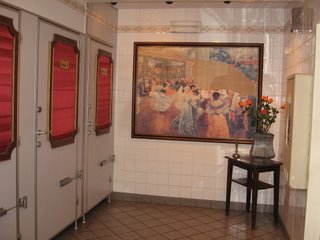 Ladies facilities in the Opera Toilet, Vienna
Ladies facilities in the Opera Toilet, Vienna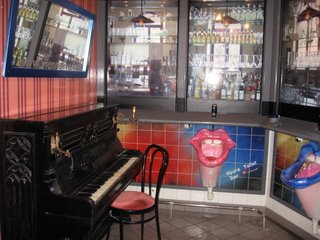 Gents' facilities in the Opera Toilet, Vienna
Gents' facilities in the Opera Toilet, ViennaOf course we had to visit the National Library of Austria. We were only admitted to the main exhibition room in the State Hall with an excellent display on the history of cooking in Austria, exhibits coming from the library's extensive collection of early printed books. We were told we could take photos provided we did not use flash. However, as soon as Ian started photographing some of the cookery books we were told off! We had to restrict our interest to the building alone. This was quite magnificent and must be one of the grandest in Europe.
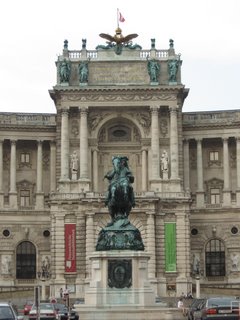 National Library of Austria, Vienna
National Library of Austria, Vienna National Library of Austria, Vienna
National Library of Austria, Vienna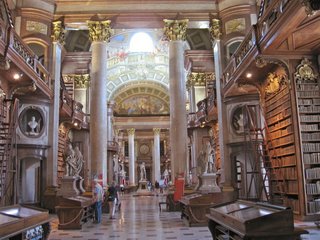 State Hall of the National Library of Austria, Vienna
State Hall of the National Library of Austria, Vienna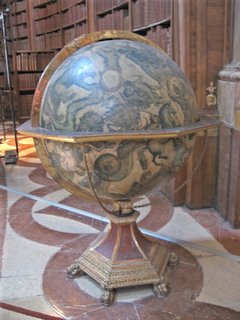 Celestial globe by Vincenzo Coronelli, Venice 1693. National Library of Austria, Vienna
Celestial globe by Vincenzo Coronelli, Venice 1693. National Library of Austria, Vienna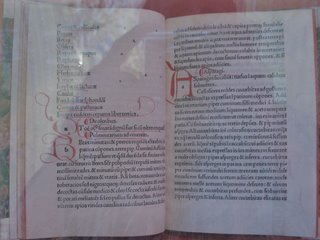 Cookery book by Bartholomaeus Platina, 1475, National Library of Austria, Vienna
Cookery book by Bartholomaeus Platina, 1475, National Library of Austria, Vienna Staircase to the State Hall, National Library of Austria, Vienna
Staircase to the State Hall, National Library of Austria, ViennaAfter a cold drink we made our way to the Spanish Riding School. However, we were too late for the last tour of the day. This was probably as well as it was very expensive and Ian wasn't wildly interested anyway. Since her riding exploits with the wild horsemen of the Puszta Jill was keen to try some dressage on a Lipizzaner stallion but it was not to be.
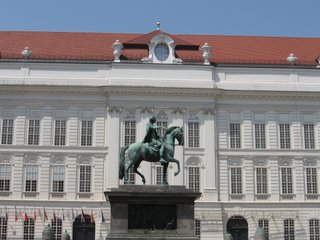 Spanish Riding School, Vienna
Spanish Riding School, ViennaThe sun was now back with renewed force as we made our way slowly along the Kärntner Strasse, Vienna's main pedestrianised area of smart shops. Here we raised false expectations for the salesman in the porcelain shop when we expressed interest in the hand painted Meissen figurines and vases. Many years ago we tried to buy a particular Meissen bowl in London but were told it would take several years to acquire it for us as the company – then in the German Democratic Republic – was limited in its output. Here today we saw the design on display but somehow the colours looked less bright than we remembered and it had lost much of its appeal. In any case it was hopelessly expensive. In the basement of an exclusive design shop we discovered a free exhibition on the work of the Viennese painter and designer, Gustav Klimt. Most of the exhibits were good reproductions but they gave an excellent flavour of work by him and his colleagues in the Wiener Werkstätte around the turn of the 19th and 20th centuries. Klimt was an innovator in many areas of design, and the exhibition included ceramics, glassware, tables, chairs, lamps and fabrics as well as paintings reproducing the vivid use of colour that was the hallmark of Klimt's work. Everything was for sale and considering what they were, the prices were far less than we would have imagined. None of the exhibits however will be gracing our own home when we return.
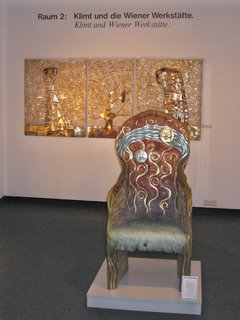 Work inspired by Klimt, Vienna
Work inspired by Klimt, Vienna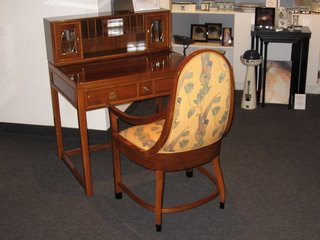 Reproduction of writing desk produced by the Wiener Werkstätte, Vienna
Reproduction of writing desk produced by the Wiener Werkstätte, Vienna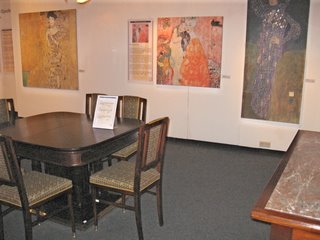 Klimt interior, Vienna
Klimt interior, ViennaOur final discovery for the day was the Secessions building, an exhibition gallery with changing displays of modern art and a frieze by Klimt which is an interpretation of Beethoven's ninth symphony. Nearby is the Naschmarkt, a permanent market with fruit and flower stalls, bakeries, cafes and small delicatessen shops selling cheeses, olives, spices and dried fruits. It was far too hot to stay long and we were exhausted having been on our feet almost all day.
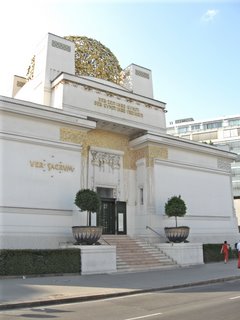 Secessionsgebäude, Vienna
Secessionsgebäude, Vienna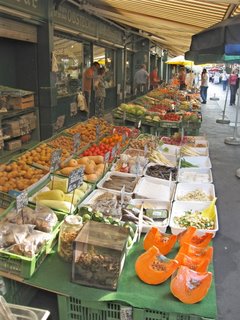 In the Naschmarkt, Vienna
In the Naschmarkt, ViennaSo we made our way to the U-Bahn and returned "home" to Modestine and welcome cool showers. Tonight there is sheet lightening and thunder is rolling around the skies. It has been raining steadily for an hour now and the temperature has dropped wonderfully! Neighbouring English campers have been here for several weeks visiting friends. They say they lived in Vienna for eleven years and have never known such hot and humid weather in June.
